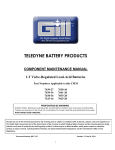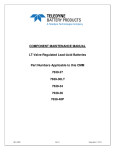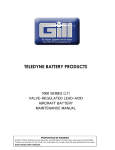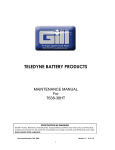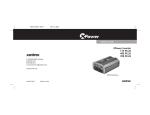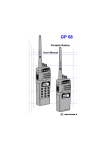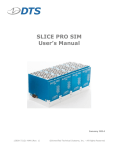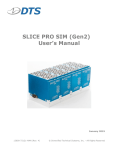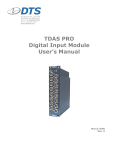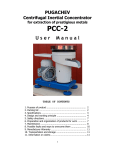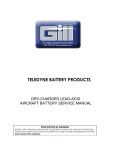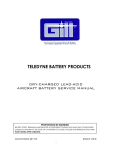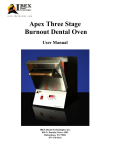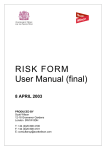Download TELEDYNE BATTERY PRODUCTS
Transcript
TELEDYNE BATTERY PRODUCTS 7000 SERIES (LT) VALVE-REGULATED LEAD-ACID AIRCRAFT BATTERY SERVICE MANUAL PROPOSITION 65 WARNING BATTERY POSTS, TERMINALS AND RELATED ACCESSORIES CONTAIN LEAD AND LEAD COMPOUNDS, CHEMICALS KNOWN TO THE STATE OF CALIFORNIA TO CAUSE CANCER AND REPRODUCTIVE HARM. WASH HANDS AFTER HANDLING. Document Number: Q01-1101 Revision : NEW 10-27-07 i Receipt and use of this technical document by any receiving party is subject to compliance with all decrees, statutes, rules and regulations of the United States Government and of the Governments of the countries in which Teledyne Battery Products and the receiving party are doing business at the time of receipt by the receiving party in effect, or which may be in effect hereafter, which govern exports or otherwise pertains to export controls, including without limitation, the Export Administration Regulations and the International Traffic in Arms Regulations. WARNING THE SAFETY INSTRUCTIONS/PRECAUTIONS POSTED IN VARIOUS SECTIONS WITHIN THIS MANUAL MUST BE STRICTLY FOLLOWED. ALWAYS WEAR SAFETY GLASSES AND ACID-RESISTANT GLOVES WHENEVER HANDLING BATTERIES ELECTROLYTE CONTAINS SULFURIC ACID, WHICH CAN PERMANENTLY DAMAGE EYES AND CAUSE SEVERE BURNS TO EXPOSED SKIN. FOR LIMITATIONS, PROCEDURES AND PERFORMANCE INFORMATION NOT CONTAINED IN THIS SUPPLEMENT CONSULT THE BASIC PILOTS OPERATING HANDBOOK, AIRPLANE FLIGHT MANUAL, THE SPECIFIC STC OR THE BATTERY CONTINUOUS AIRWORTHINESS INSTRUCTIONS FOR THE APPLICATION. THIS SERVICE MANUAL SHOULD NOT BE CONSTRUED AS THE FINAL AUTHORITY IN MAINTAINING YOUR SPECIFIC BATTERY. PLEASE CONSULT WITH TELEDYNE TECHNICAL SUPPORT FOR FURTHER INFORMATION. ii COMPONENT MAINTENANCE MANUAL CONTENTS Section Page 1. REVISION PAGE …………………………………………………………. 3. LT VALVE-REGULATED LEAD-ACID BATTERIES 2. SCOPE …………………………………………………………. 3 …………………………………………. 3 Description 3.3 STC Kit Purchase …………………………………………. Specifications 4. SERVICE INSTRUCTIONS …………………………………………. 4 …………………………………………. 6 4.1 Shipment of Batteries 4.2 Inspection for Shipping Damage 4.4 4.3 …………………………………. 6 Storage Requirements …………………………………. 6 Initial Inspection …………………………………. 8 …………………………………………………………. 9 5.1 Overview 5.2 5.3 7 …………………………………………. 9 Constant-Current …………………………………. 9 Constant-Voltage …………………………………. 11 …………………………………………. 14 Overcharging 6. ROUTINE MAINTENANCE …………………………………………. 6.1 Inspection/Service Period 6.2 Continued Airworthiness Requirement - Capacity Testing …………………………. …………………………. 6.3 Inspection of Connectors 6.4 Recovery from Deep-Discharge 7. UNSCHEDULED REMOVAL 8. TRANSPORTATION 9. RECYCLING 10. GLOSSARY …………………………. 14 14 15 15 …………………………………………. 17 …………………………………………………. 18 …………………………………………………………. 21 …………………………………………………………. 13. APPENDIX C MSDS 19 …………………………. 22 …………………………………………………. 26 12. APPENDIX B LT VRLA Battery Specifications …………………………. 14. APPENDIX D FAA-PMA List Revision: New 13 …………………. 11. APPENDIX A LT VRLA Battery Capacities Q01-1101 5 …………………. 5. CHARGING 5.4 2 …………………. 3.1 3.2 1 …………………………………………. iii Teledyne Battery Products 23 35 Section 1 COMPONENT MAINTENANCE MANUAL REVISIONS NC Q01-1101 Description of Change New document Rev NC 10-27-07 Page 1 of 38 Approved By Date JMR 10-27-07 Teledyne Battery Products Premium LT Valve Regulated Lead Acid Aircraft Batteries By TELEDYNE BATTERY PRODUCTS Revision Section 2 COMPONENT MAINTENANCE MANUAL SCOPE (LT VRLA) Aircraft Batteries manufactured under FAA Parts Manufacturer Approval number PQ1006NM for type certificated aircraft. This manual has been written for the purpose of guidance only; consult Teledyne Battery Products Technical Support for further information. The latest list of our PMA’s can be obtained on our website at: www.gillbatteries.com or by calling our Customer Support at (800) 456 0070. Q01-1101 Rev NC 10-27-07 Page 2 of 38 Teledyne Battery Products Premium LT Valve Regulated Lead Acid Aircraft Batteries By TELEDYNE BATTERY PRODUCTS This manual provides Maintenance Procedures for Gill 7000 Series Valve-Regulated Lead-Acid Section 3 COMPONENT MAINTENANCE MANUAL VALVE-REGULATED LEAD-ACID BATTERIES DESCRIPTION 3.1.1 The 7000 series valve-regulated lead-acid (VRLA) batteries are designed with an optimum lead alloy with tin and copper to provide the best possible electrode characteristics necessary for performance. These VRLA batteries contain electrolyte absorbed in glass-mat separators, with no free electrolyte and are sometimes referred to as “sealed” or “recombinant-gas” batteries. WARNING ALL VRLA batteries contain sulfuric acid, which is highly corrosive and which can cause serious physical injury if it comes in contact with skin or if inhaled. It can also cause serious eye injury or blindness if it comes into contact with the eyes. Caution must be exercised to avoid damage to the exterior case which could allow the contents to escape or come in physical contact with external materials or personnel. If a battery case is found to be damaged, handle the battery with care and avoid contact with the skin. Inspect all areas adjacent to the battery for evidence of corrosion. 3.1.2 Gill valve-regulated lead-acid batteries have vent caps (with valves enclosed) that are sealed in place and cannot be accessed for maintenance. At no time must these vent caps be removed. WARNING During normal operation, the batteries will vent very small amounts of gases that must be vented away from the battery and aircraft. The venting mechanisms consist of nozzles (in the battery cover) and vent tubes that are designed to exhaust the battery compartment. Ensure that the vent tubes are not restricted or disabled in any way. 3.1.3 The electrolyte is contained in an absorptive glass-mat (AGM) separator that retains and immobilizes the electrolyte. These batteries can be operated in any orientation without spilling electrolyte. 3.1.4 Q01-1101 The battery consists of twelve cells connected in series internally, making up a 24V battery, or six cells for 12V batteries. These cells are not replaceable. Rev NC 10-27-07 Page 3 of 38 Teledyne Battery Products Premium LT Valve Regulated Lead Acid Aircraft Batteries By TELEDYNE BATTERY PRODUCTS 3.1 COMPONENT MAINTENANCE MANUAL 3.1.5 Each cell is constructed of premium grade LT electrodes (plates) that are electrically isolated by AGM separators. These cells are inserted in the battery electrolyte with the tight pack providing good resistance to vibration. 3.2 SPECIFICATIONS 3.2.1 Gill battery ratings are defined by a series of specifications: 3.2.1.1 The One-Hour Rate This is the rate of discharge a battery can endure for one hour with the battery voltage at or above 1.67 volts per cell, or 20 volts for a 24 volt lead-acid battery, or 10 volts for a 12 volt lead-acid battery. The One-Hour Capacity, measured in Ampere Hours or Ah, is the product of the discharge rate and time (in hours) to the specified end voltage. 3.2.1.2 The Emergency Rate This is the rate of discharge a battery can endure for thirty minutes with the battery voltage at or above 1.67 volts per cell, or 20 volts for a 24 volt lead-acid battery, or 10 volts for a 12 volt lead-acid battery. The Emergency Rate is the total essential load, measured in amperes, required to support the essential bus for thirty minutes. 3.2.1.3 Ipp: This is the peak current delivered at 0.3 seconds into a 15 second controlled discharge at a constant terminal voltage of half the nominal battery voltage. Ipr: This is the discharge current at the conclusion of a 15 second controlled discharge at a constant terminal voltage of half the nominal battery voltage. 3.2.2 Q01-1101 State of charge using voltage measurements should be used as a guide only. Figure 1 indicates the relationship between Battery Open-Circuit Voltage (OCV) Rev NC 10-27-07 Page 4 of 38 Teledyne Battery Products Premium LT Valve Regulated Lead Acid Aircraft Batteries By TELEDYNE BATTERY PRODUCTS case under compression that helps to provide consistent availability of COMPONENT MAINTENANCE MANUAL and % State-of-Charge (SOC). Please note that state-of-charge is not the same as available capacity (see GLOSSARY). Open Circuit Voltage 24V LT Valve-Regulated Lead-Acid Battery 26.8 Terminal Voltage 26.3 25.8 25.3 24.8 24.3 0 10 20 30 40 50 60 70 80 90 100 % State Of Charge 3.2.3. All valve-regulated batteries operate best in controlled temperatures. Excessive excursions above 1000F can shorten the life of lead-acid batteries. The optimum operating temperature is around 800F. Available capacity declines as the temperature drops. This decline is primarily related to the state of the electrolyte and easily recoverable once the battery has warmed up sufficiently. 3.3 STC KIT PURCHASE 3.3.1 GILL STC KITS have been manufactured pursuant to FAA-Parts Manufacturer Approval (FAA-PMA) and are designed for use only with specified GILL batteries and parts. Teledyne Continental Motors Battery Products accepts no responsibility for any failure caused by any battery or part used with these kits which it does not manufacture, supply or specify. Q01-1101 Rev NC 10-27-07 Page 5 of 38 Teledyne Battery Products Premium LT Valve Regulated Lead Acid Aircraft Batteries By TELEDYNE BATTERY PRODUCTS Figure 1 Section 4 COMPONENT MAINTENANCE MANUAL SERVICE INSTRUCTIONS SHIPMENT OF BATTERIES 4.1.1 The batteries are shipped conditioned and fully charged. 4.1.2 Each battery is identified with a unique serial number label and manufacturing date marked with indelible ink on the right side of the battery (side adjacent to the positive terminal, with the terminals facing forward). Please use this manufacturing date for future reference. 4.2 INSPECTION FOR SHIPPING DAMAGE 4.2.1 Upon receipt, the packages must be examined for any shipping damage before they are placed in storage or use. If any damage is noted, contact the shipping company immediately. 4.2.2 Type verification can be performed by checking the serial number label on the packaging against the accompanying FAA Form 8130-3 or Certificate of Compliance. 4.3 STORAGE REQUIREMENTS 4.3.1 Teledyne’s 7000 series valve-regulated lead-acid batteries can be stored between -200F and +1100F (store ideally at 800F). Storage at temperatures other than these, can lead to permanent damage. Storage temperatures will determine inspection requirements. 4.3.2 Teledyne’s 7000 series valve-regulated lead-acid batteries have a maximum of 24 months of inspection-free storage life, IF stored at temperatures between 400F to 800F. Batteries maintained at lower temperatures should be reviewed in this category as well. Q01-1101 Rev NC 10-27-07 Page 6 of 38 Teledyne Battery Products Premium LT Valve Regulated Lead Acid Aircraft Batteries By TELEDYNE BATTERY PRODUCTS 4.1 COMPONENT MAINTENANCE MANUAL 4.3.3 Review figure 2 to determine the shelf life at various temperatures indicated. The 7000 series batteries can be stored for the number of days at the Figure 2 Shelf Life for 7000 Series LT VRLA Batteries In Days to 30% State of Charge Storage Time - Days 10,000 1,000 100 10 0 0 15 C (59 F) 0 0 20 C (68 F) 0 0 25 C (77 F) 0 0 30 C (86 F) 0 0 35 C(95 F) Storage Temperature 4.3.4 If stored between 950F (350C) to 1100F (430C), the battery must be inspected on a monthly basis. It is not recommended to store any VRLA batteries at these temperatures for excessive periods of time (maximum 3 months storage). Prolonged storage at high temperatures (over 1100F) will reduce battery life. 4.3.5 All batteries returned from service after initial use must be stored fully charged. The storage start date and battery voltage must be logged on the outer package or marked on the battery. 4.3.6 Long term storage at low temperatures (around 00F) will not detrimentally affect the life of the battery, provided the battery is at a reasonably high state of charge (over 80%) before placing in storage. Q01-1101 Rev NC 10-27-07 Page 7 of 38 Teledyne Battery Products Premium LT Valve Regulated Lead Acid Aircraft Batteries By TELEDYNE BATTERY PRODUCTS temperature indicated in Figure 2 without any damage. COMPONENT MAINTENANCE MANUAL 4.3.7 and recharge periods. INITIAL INSPECTION 4.4.1 Visually inspect the battery to ensure there is no damage. Remove the protective cap over the terminal pins and ensure that the pins are clean and there is no corrosion. The pins have been installed with the correct torque at the factory and do not require any re-seating. Call Gill Technical Support if you find any discrepancy. 4.4.2 DO NOT remove the lid. This is a “sealed” battery and does not need any other 4.4.3 Inspect the open circuit voltage. Typical practice should be to recharge the maintenance. battery at constant potential before placing into service. Review section 5 for all charging instructions. For basic charging, constant-potential is the preferred charging method. Deepdischarge recovery will usually require application of Constant-Current and/or Constant-Potential charging (see 6.4). Please consult with technical support at Teledyne before attempting recovery from prolonged deep-discharge. WARNING ALL VRLA batteries contain sulfuric acid, which is highly corrosive and which can cause serious physical injury if it comes in contact with skin or if inhaled. It can also cause serious eye injury or blindness if it comes into contact with the eyes. Caution must be exercised to avoid damage to the exterior case which could allow the contents to escape or come in physical contact with external materials or personnel. If a battery case is found to be damaged, handle the battery with care and avoid contact with the skin. Inspect all areas adjacent to the battery for evidence of corrosion. 4.4.4 Charging should be terminated when the charge current drops to less than 0.5 ampere (typically takes up to 15 hours depending on the state-of-charge of the battery). Q01-1101 Rev NC 10-27-07 Page 8 of 38 Teledyne Battery Products Premium LT Valve Regulated Lead Acid Aircraft Batteries By TELEDYNE BATTERY PRODUCTS 4.4 Please call Gill technical support if there are any questions regarding shelf life Section 5 COMPONENT MAINTENANCE MANUAL RECOMMENDATION Charging should be conducted in a well-ventilated area at ambient conditions ranging from 650F to 800F. 5.1 OVERVIEW 5.1.1 Please review the charging method (constant-current or constant-voltage) before commencing. The preferred method is constant-voltage. 5.1.2 Correct charging is very important and will affect the overall life of the battery. The charging process is not 100% efficient due to losses resulting from internal resistance and will typically require 10% to 20% more recharge than the amount of capacity removed during discharge. 5.1.3 Undercharging a battery occurs when the required 110% to 120% of the removed capacity is not returned during recharge. If this occurs repeatedly, residual lead sulfate will eventually increase in the plates, making it difficult to fully recharge the battery. In this case the battery will suffer a permanent loss of capacity. 5.1.4 Overcharging generally occurs when either constant-current charging is used without adequate control of total time on-charge or the voltage limit in constant-voltage charge is higher than the recommended range (see 5.3.4). Overcharging a battery will corrode the positive grids and break-down the water component in the electrolyte to hydrogen and oxygen (electrolysis). This is quite detrimental to the life of VRLA batteries since the water cannot be replaced. 5.2 CONSTANT-CURRENT (CI) 5.2.1 These chargers must be capable of providing an output of ~ 35 volts and ~ 8 amperes (with selector switch) and provide a timer that can terminate charging when the required charge input is provided. 5.2.2 Q01-1101 The ampere hours of energy restored is the product of rate of charge (in amperes) and the time (in hours). Rev NC 10-27-07 Page 9 of 38 Teledyne Battery Products Premium LT Valve Regulated Lead Acid Aircraft Batteries By TELEDYNE BATTERY PRODUCTS CHARGING COMPONENT MAINTENANCE MANUAL 5.2.3 Since these chargers are designed to provide a constant current throughout the charging period, this method can lead to overcharging if not controlled. In 5.2.4 In order to reduce heat and minimize corrosion, it is preferred to use low rates (0.5amps to 5 amps) when charging batteries using this technique. Note explanation in 6.4 “Deep Discharge Recovery” for general outline on using constant current recharge. The battery will get slightly warm during charge. Measured at the surface of the case, the battery temperature should not exceed 1000F. 5.2.5 For a complete list of all battery types and the charging rates, please use Table 1. Table 1 CONSTANT-CURRENT CHARGING RATES 24 VOLT BATTERIES Battery No Load Voltage One-Hour Capacity (Ah) 6.5 10 >26.3 13 15 20 Charge 24 44 Time Charge Rates (Amps) (Hr) Charging Not Required 0 26.1 to 26.3 0.5 0.5 0.5 0.5 1 1 2 5 25.8 to 26.0 0.5 0.5 0.5 0.5 1 1 2 9 25.5 to 25.7 0.5 0.5 1 1.5 1 1 2 13 12 VOLT BATTERIES Battery No Load Voltage >13.2 Q01-1101 Products One-Hour Capacity (Ah) 18 23 Charge Rate (Amps) Charging Not Required Charge Time (Hr) 0 13 to 13.2 1 1 12.8 to 12.9 1 1 9 12.6 to 12.7 1 1 13 Rev NC 10-27-07 Page 10 of 38 5 Teledyne Battery Premium LT Valve Regulated Lead Acid Aircraft Batteries By TELEDYNE BATTERY PRODUCTS order to control the charge input, these chargers must have a shut-off timer. COMPONENT MAINTENANCE MANUAL 5.3 CONSTANT-VOLTAGE (CV) These chargers are generally designed to provide a constant voltage source, with selectable initial current rates. Model variants provide selectable charge voltage and initial charge rates. Higher output current will reduce recharge time. 5.3.2 Because the current in any circuit is directly proportional to the voltage gradient across that circuit, CV charging will result in a high initial charging current which will start dropping off when the voltage gradient between the charger and battery begins to decrease. 5.3.3 Typically, the charger will regulate to 28.4 volts (24 volt batteries) or 14.2 volts (12 volt batteries). As the battery approaches the charger output voltage, charge current will drop below 0.5 ampere. Figure 3 Temperature Compensated Charge Voltages Valve-Regulated Lead-Acid Batteries 2.70 2.65 2.60 Charge Voltage Per Cell 2.55 2.50 2.45 2.40 2.35 2.30 2.25 2.20 10 Q01-1101 Products 15 20 25 30 35 40 45 Rev NC 10-27-07 50 55 60 65 70 Temperature (0F) 75 80 85 Page 11 of 38 90 95 100 105 110 115 120 Teledyne Battery Premium LT Valve Regulated Lead Acid Aircraft Batteries By TELEDYNE BATTERY PRODUCTS 5.3.1 COMPONENT MAINTENANCE MANUAL 5.3.4 The battery must be connected to the charger with output voltage set between on until the charge rate drops below 1 ampere. At this point, disconnect the charger from its power source first before disconnecting the battery from the charger. Disconnecting the charger first will eliminate any sparks, since the battery could still be accepting a low rate of charge. Note: Unless the charger is of a type that turns off automatically, you must disconnect the charger and battery once the charge rate drops below 0.5 ampere. 5.3.5 Alternatively, constant-voltage charging can be temperature-compensated for better control. Note Figure 3 for Temperature Compensated Charge Voltages. 5.3.6 Figure 4 represents Teledyne Battery Products’ TSC-O1V Charger profile. This is a specialized charger that provides a constant-current charge initially; thereafter, it switches to constant-voltage charge to the battery. Figure 4 TSC-01V Charge Profile 30.00 10.00 Constant-Current Period 9.00 Constant-Voltage Period 8.00 25:13:59 24:00:00 23:00:00 22:02:00 21:00:00 20:00:00 19:02:00 18:00:00 17:00:00 16:00:00 0.00 15:00:00 25.00 14:00:00 1.00 13:00:00 25.50 12:00:00 2.00 11:00:00 26.00 9:00:00 3.00 10:00:00 26.50 8:00:00 4.00 7:00:00 27.00 6:00:00 5.00 5:00:00 27.50 4:00:00 6.00 3:00:00 28.00 2:00:00 7.00 1:00:00 28.50 0:00:00 On-Charge Voltage (V) 29.00 Rate of Charge (A) 29.50 Charge Time (HH:MM:SS) Q01-1101 Products Rev NC 10-27-07 Page 12 of 38 Teledyne Battery Premium LT Valve Regulated Lead Acid Aircraft Batteries By TELEDYNE BATTERY PRODUCTS 28.2V up to 29.0V for 24V batteries (14.1V to 14.5V for 12V batteries) and left COMPONENT MAINTENANCE MANUAL 5.4 OVERCHARGING Overcharging will occur when using uncontrolled constant-current charging or if the voltage limit on a constant-voltage charger is higher than the manufacturer’s recommended value (see 5.3.4). 5.4.2 Prolonged overcharging will lead to loss of water from the electrolyte – in the form of gassing and grid corrosion. Please call Gill Technical Support for any additional concerns with charging. Q01-1101 Products Rev NC 10-27-07 Page 13 of 38 Teledyne Battery Premium LT Valve Regulated Lead Acid Aircraft Batteries By TELEDYNE BATTERY PRODUCTS 5.4.1 Section 6 COMPONENT MAINTENANCE MANUAL ROUTINE MAINTENANCE INSPECTION/SERVICE PERIOD After initial installation, Gill requires a capacity check of the battery to be performed at 1,200 hours or 12 months, whichever comes first, with subsequent capacity checks performed every 600 hours or 6 months. Please refer to aircraft manufacturer’s guidelines for further clarification. WARNING The battery must be removed from the installation and serviced in a well-ventilated designated area. During servicing, the battery will generate oxygen and hydrogen gases, which can be explosive under the right conditions. 6.1.1 Battery Integrity Visually inspect the battery for any signs of cracks, corrosion, unusual terminal pin wear or discoloration on the pins. WARNING ALL VRLA batteries contain sulfuric acid, which is highly corrosive and which can cause serious physical injury if it comes in contact with skin or if inhaled. It can also cause serious eye injury or blindness if it comes into contact with the eyes. Caution must be exercised to avoid damage to the exterior case which could allow the contents to escape or come in physical contact with external materials or personnel. If a battery case is found to be damaged, handle the battery with care and avoid contact with the skin. Inspect all areas adjacent to the battery for evidence of corrosion. 6.2 CONTINUED AIRWORTHINESS REQUIREMENT – CAPACITY TESTING During this inspection process the following components must be reviewed: 6.2.1 Q01-1101 Products Measure and record the battery voltage. Rev NC 10-27-07 Page 14 of 38 Teledyne Battery Premium LT Valve Regulated Lead Acid Aircraft Batteries By TELEDYNE BATTERY PRODUCTS 6.1 COMPONENT MAINTENANCE MANUAL 6.2.2 Charge the battery using Constant-Current or Constant-Voltage methods described in Section 5. Allow the battery to rest for 4 hours before commencing the discharge test. 6.2.4 The battery should be discharged at the 1 hour rate (see Table 2, Appendix A) to an end voltage of 1.67 volts per cell or 20 volts (per IEC 60952-1). Measure the time. The battery must achieve at least 80% of the rated time (or 48 minutes at the 1 hour rate). If the first discharge time is less than 48 minutes, repeat the cycle one more time. 6.2.5 If the second discharge fails to deliver at least 48 minutes, the battery should 6.2.6 If the discharge cannot be conducted according to the rates required, Teledyne be rejected. Call Gill Technical Support for further details. Gill can provide the appropriate discharge curve for that battery and suggest alternative rates. These performance curves are also in Appendix C. Call Gill Technical Support for additional instructions. 6.2.7 Once the battery has passed all required inspections and after it is fully recharged using constant-voltage charging methods, the battery is ready for installation. 6.3 INSPECTION OF CONNECTORS 6.3.1 Before reconnecting to the aircraft, ensure that the connector sockets have not worn or become loose. This inspection can be performed with a go-no-go gauge, part number 3600-51, obtained from Teledyne Gill. 6.4 DEEP-DISCHARGE RECOVERY 6.4.1 Deep discharge is usually indicated by a battery voltage of less than 21 volts. A battery which has been deeply discharged can be recharged using constant- current charging techniques. Constant-voltage method is not recommended. 6.4.2 Q01-1101 Products The battery should be charged at a rate of 1.0A for a total input (in amperehours) of 200% of the one-hour capacity, which is determined as follows: Rev NC 10-27-07 Page 15 of 38 Teledyne Battery Premium LT Valve Regulated Lead Acid Aircraft Batteries By TELEDYNE BATTERY PRODUCTS 6.2.3 COMPONENT MAINTENANCE MANUAL For example, for a one-hour capacity of 44 Ah, the charge time is determined as follows: At the charge rate of 1.0 amperes, the total charge time would be: 88 Ah/1.0A = 88 hours 6.4.3 Stable voltage, measured 2 hours after charge termination, should be between 26.3V to 26.5V for 24V batteries and 13.1V to 13.3V for 12V batteries. If the voltage falls below the range specified, charging should be resumed using guidelines in 5.3. Charging the battery to voltages higher than specified can shorten battery life. 6.4.4 Q01-1101 Products Avoid subjecting a battery to frequent deep discharges as this can reduce the useful life of the battery. Rev NC 10-27-07 Page 16 of 38 Teledyne Battery Premium LT Valve Regulated Lead Acid Aircraft Batteries By TELEDYNE BATTERY PRODUCTS 2 x 44Ah = 88 Ah (Ampere-hours) needed. Section 7 COMPONENT MAINTENANCE MANUAL UNSCHEDULED REMOVALS Unscheduled removals may be required when the battery has been inadvertently discharged or has a premature failure. Recharging the battery using Constant Current method described in 5.2 should be attempted. . Perform a capacity check as outlined in 6.2.3 through 6.2.6. If the battery fails to provide specified capacity as noted in Table 2, Appendix A, it should be rejected. 7.2 In lieu of the capacity test set forth above, testing on an installed battery may be performed during the 400-hour maintenance check, or the periodic maintenance interval performed by the service center. This test entails a battery OCV check which is compared to the graph in Figure 1. If the voltage is below 75% state-of-charge, the battery should be pulled out for servicing as outlined in Section 6. Q01-1101 Products Rev NC 10-27-07 Page 17 of 38 Teledyne Battery Premium LT Valve Regulated Lead Acid Aircraft Batteries By TELEDYNE BATTERY PRODUCTS 7.1 Section 8 COMPONENT MAINTENANCE MANUAL TRANSPORTATION Gill LT VRLA batteries are classified as “Nonspillable” and are exempted from all other requirements of 49 CFR, Chapter 1, Subchapter C, Parts 106 – 180, as determined in: a) US Department of Transportation’s 49CFR, Chapter 1, Part 173.159, paragraph “d” b) IATA/ICAO Packing Instructions 806, Provision A67 Q01-1101 Products Rev NC 10-27-07 Page 18 of 38 Teledyne Battery Premium LT Valve Regulated Lead Acid Aircraft Batteries By TELEDYNE BATTERY PRODUCTS 8.1 Section 9 COMPONENT MAINTENANCE MANUAL RECYCLING MATERIAL SAFETY DATA SHEETS 9.1.1 9.2 These have been included in Appendix C. They can be downloaded as needed from the Gill website: www.gillbatteries.com RECYCLER LOCATIONS 9.2.1 All parts of spent lead-acid batteries are recyclable. Generally, batteries are collected by retailers and wholesalers who send large quantities to battery recyclers for reclamation. Battery recyclers are permitted hazardous waste treatment recycling facilities. If you have just a few batteries you should contact your local battery retailers or wholesalers. 9.2.2 The following is a listing of recyclers in California: GNB, Inc. Resource Recycling Division 2700 South Indiana Street Los Angeles, CA 90023 (213) 262-1101 RSR Quemetco, Inc. 720 South 7th Avenue City of Industry, CA 91745 (800)527-9452 9.2.3 The California Department of Toxic Substances Control publishes an annual listing of commercial hazardous waste recyclers, which also includes facilities outside of California. A copy of this publication, the "Directory of Industrial Recyclers" may be obtained by calling (916) 324-2423, or writing to the: California Waste Exchange Resource Recovery Unit Hazardous Waste Management Program Department of Toxic Substances Control P.O. Box 806 Sacramento, CA 95812-0806 Q01-1101 Products Rev NC 10-27-07 Page 19 of 38 Teledyne Battery Premium LT Valve Regulated Lead Acid Aircraft Batteries By TELEDYNE BATTERY PRODUCTS 9.1 COMPONENT MAINTENANCE MANUAL 0 9.2.4 Nation-wide Recycling: batteries will accept a small number (one or two) of spent lead-acid batteries for recycling. If you have a larger quantity to be recycled, call to verify that your chosen outlet can handle a larger quantity of old batteries. Even if you live in a state where there is no lead-acid battery recycling law, it's common for battery retailers everywhere in the U.S. to accept used lead-acid batteries from customers. The spent batteries collected by retailers are shipped to EPA licensed and regulated facilities for recycling. For additional information, please use the following web address to locate nation-wide recycling facilities: www.batterycouncil.org 9.3 INTERNATIONAL RECYCLING RESOURCES 9.3.1 British Battery Manufacturers Association 26 Grosvenor Gardens London SW1W 0GT Direct Tel: +44 (0) 207 838 4800 Direct Fax: +44 (0) 207 838 4801 9.3.2 SNAM (Societe Nouvelle d'Affinage des Metaux) Rue de la Garenne St Quentin Sallavier 38297 La Verpilliere Cedex France Telephone: 00 33 74 945 985 Battery re-processing. 9.3.3 Q01-1101 Products For smaller batteries, you may also contact the Rechargeable Battery Recycling Corporation (RBRC) at www.rbrc.com for directions. Rev NC 10-27-07 Page 20 of 38 Teledyne Battery Premium LT Valve Regulated Lead Acid Aircraft Batteries By TELEDYNE BATTERY PRODUCTS Most retailers, auto parts stores or service outlets that sell new lead-acid Section 10 COMPONENT MAINTENANCE MANUAL GLOSSARY The formed (charged) material on the positive and negative electrodes AGM Absorptive Glass Mat, a non-woven fiberglass separator that holds the Ah (plates). electrolyte. Ampere-hour; the standard designation of capacity units for batteries. CFR Code of Federal Regulations. Electrolyte The liquid added to a battery that is capable of conducting ions between Electrolysis Decomposition of an electrolyte by the action of an electric current IATA International Air Transport Association. ICAO International Civil Aviation Organization. IEC International Electrotechnical Commission. Ipp Peak current delivered at 0.3 seconds into a 15 second controlled the two electrodes. flowing through the electrodes (positive and negative plates). discharge at a constant terminal voltage of half the nominal battery voltage. Ipr Discharge current at the conclusion of a 15 second controlled discharge Nonspillable Refers to the ability of the battery to retain the electrolyte when at a constant terminal voltage of half the nominal battery voltage subjected to tests identified under US DOT Reg 49 CFR, Part 173.159, paragraph “d”. OCV Open Circuit Voltage; measured with no loads connected to the battery. Passivation Refers to the oxidation of the negative electrode. Recombination The process by which oxygen combines (reacts) with the negative active Sponge lead Fully charged negative plates convert to a very porous pure lead material. material, often referred as sponge lead since it resembles a sponge under high magnification. State of Charge The measure of charge level of a battery. This measure is not the same as available capacity. A “spent” battery could indicate a full state of charge (voltage) but has lower capacity than the battery started out with. Sulfation Venting Q01-1101 Products The product of discharge, lead sulfate, formed on both positive and negative plates. Means for a battery to release the gases it generates during charging. Rev NC 10-27-07 Page 21 of 38 Teledyne Battery Premium LT Valve Regulated Lead Acid Aircraft Batteries By TELEDYNE BATTERY PRODUCTS Active material Section 11 COMPONENT MAINTENANCE MANUAL APPENDIX A VRLA Battery Capacities Battery 1 Hour Rate 30 Minute Rate 7639-27 24 27 42 7638-44 24 44 70 Type Q01-1101 Products Voltage Rev NC 10-27-07 (A) Page 22 of 38 (Amps) Teledyne Battery Premium LT Valve Regulated Lead Acid Aircraft Batteries By TELEDYNE BATTERY PRODUCTS Table 2 COMPONENT MAINTENANCE MANUAL APPENDIX B Premium LT Valve Regulated Lead Acid Aircraft Batteries By TELEDYNE BATTERY PRODUCTS VRLA Battery Specifications and Performance Curves 1) 2) Q01-1101 Products 7639-27 7638-44 Rev NC 10-27-07 Page 23 of 38 Teledyne Battery 7639-27 COMPONENT MAINTENANCE MANUAL Power Rating, Current, at Various Temperatures Run time Watts Amps Capacity (Ah) Energy (Wh) 60 sec. (@ -18°C 1.2 Volts per cell) 5,727 415 7 95 1 hr (@ 24°C 1.67 Volts per cell) 581 27 27 581 30 min. (@ 24°C 1.67 Volts per cell) 970 45 23 485 Ipp @ 24°C (A) Ipr @ 24°C (A) Ipp @ -18°C (A) Ipr @ -18°C (A) Ipp @ -30°C (A) Ipr @ -30°C (A) 1,574 1,142 1,104 734 866 596 Battery Weight (lb) 62 7639-27 Performance at 24°C 100 45 27 2 970 581 48 Amperes 0.5 1 20 10 1 0.1 Q01-1101 Products 1 Rev NC 10-27-07 Hours to 1.67 VPC at 24°C 10 Page 24 of 38 100 Teledyne Battery Premium LT Valve Regulated Lead Acid Aircraft Batteries By TELEDYNE BATTERY PRODUCTS 7639-27 Performance Data 7638-44 COMPONENT MAINTENANCE MANUAL Power Rating, Current, at Various Temperatures Discharge Watts Amps Capacity (Ah) Energy (Wh) 60 sec. (@ -18°C to 1.2 Volts per cell) 9,438 600 10 157 30 min. (@ 24°C to 1.67 Volts per cell) 1,714 70 35 857 1 hr (@ 24°C to 1.67 Volts per cell) 1,058 44 44 1,058 Ipp @ 24°C (A) Ipr @ 24°C (A) Ipp @ -18°C (A) Ipr @ -18°C (A) Ipp @ -30°C (A) Ipr @ -30°C (A) 1,857 1,247 1,677 1,051 1,411 948 Battery Weight (lb) 86 ` 7638-44 Performance at 24°C 100 70 44 3.5 1714 1058 84 Amperes 0.5 1 20 10 1 0.1 Q01-1101 Products 1 Rev NC 10-27-07 Hours to 1.67 VPC at 24°C Page 25 of 38 10 100 Teledyne Battery Premium LT Valve Regulated Lead Acid Aircraft Batteries By TELEDYNE BATTERY PRODUCTS 7638-44 Performance COMPONENT MAINTENANCE MANUAL Q01-1101 Products Rev NC 10-27-07 Page 26 of 38 Premium LT Valve Regulated Lead Acid Aircraft Batteries By TELEDYNE BATTERY PRODUCTS APPENDIX C Teledyne Battery COMPONENT MAINTENANCE MANUAL Premium LT Valve Regulated Lead Acid Aircraft Batteries By TELEDYNE BATTERY PRODUCTS Q01-1101 Products Rev NC 10-27-07 Page 27 of 38 Teledyne Battery COMPONENT MAINTENANCE MANUAL Premium LT Valve Regulated Lead Acid Aircraft Batteries By TELEDYNE BATTERY PRODUCTS Q01-1101 Products Rev NC 10-27-07 Page 28 of 38 Teledyne Battery COMPONENT MAINTENANCE MANUAL Premium LT Valve Regulated Lead Acid Aircraft Batteries By TELEDYNE BATTERY PRODUCTS Q01-1101 Products Rev NC 10-27-07 Page 29 of 38 Teledyne Battery COMPONENT MAINTENANCE MANUAL Premium LT Valve Regulated Lead Acid Aircraft Batteries By TELEDYNE BATTERY PRODUCTS Q01-1101 Products Rev NC 10-27-07 Page 30 of 38 Teledyne Battery COMPONENT MAINTENANCE MANUAL Premium LT Valve Regulated Lead Acid Aircraft Batteries By TELEDYNE BATTERY PRODUCTS Q01-1101 Products Rev NC 10-27-07 Page 31 of 38 Teledyne Battery COMPONENT MAINTENANCE MANUAL Premium LT Valve Regulated Lead Acid Aircraft Batteries By TELEDYNE BATTERY PRODUCTS Q01-1101 Products Rev NC 10-27-07 Page 32 of 38 Teledyne Battery COMPONENT MAINTENANCE MANUAL Premium LT Valve Regulated Lead Acid Aircraft Batteries By TELEDYNE BATTERY PRODUCTS Q01-1101 Products Rev NC 10-27-07 Page 33 of 38 Teledyne Battery COMPONENT MAINTENANCE MANUAL Premium LT Valve Regulated Lead Acid Aircraft Batteries By TELEDYNE BATTERY PRODUCTS Q01-1101 Products Rev NC 10-27-07 Page 34 of 38 Teledyne Battery COMPONENT MAINTENANCE MANUAL Q01-1101 Products Rev NC 10-27-07 Page 35 of 38 Premium LT Valve Regulated Lead Acid Aircraft Batteries By TELEDYNE BATTERY PRODUCTS APPENDIX D Teledyne Battery COMPONENT MAINTENANCE MANUAL Premium LT Valve Regulated Lead Acid Aircraft Batteries By TELEDYNE BATTERY PRODUCTS Q01-1101 Products Rev NC 10-27-07 Page 36 of 38 Teledyne Battery COMPONENT MAINTENANCE MANUAL Premium LT Valve Regulated Lead Acid Aircraft Batteries By TELEDYNE BATTERY PRODUCTS Q01-1101 Products Rev NC 10-27-07 Page 37 of 38 Teledyne Battery COMPONENT MAINTENANCE MANUAL Premium LT Valve Regulated Lead Acid Aircraft Batteries By TELEDYNE BATTERY PRODUCTS Q01-1101 Products Rev NC 10-27-07 Page 38 of 38 Teledyne Battery









































